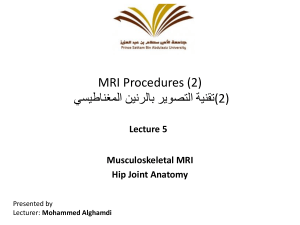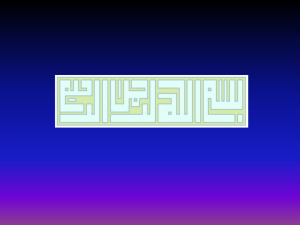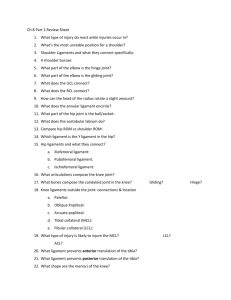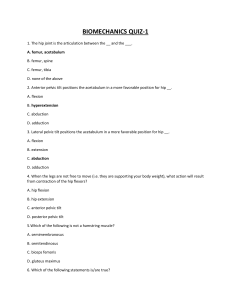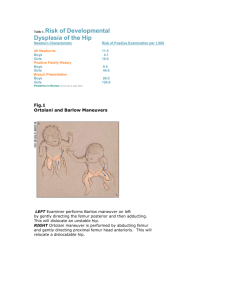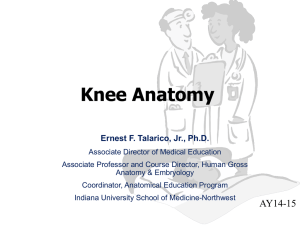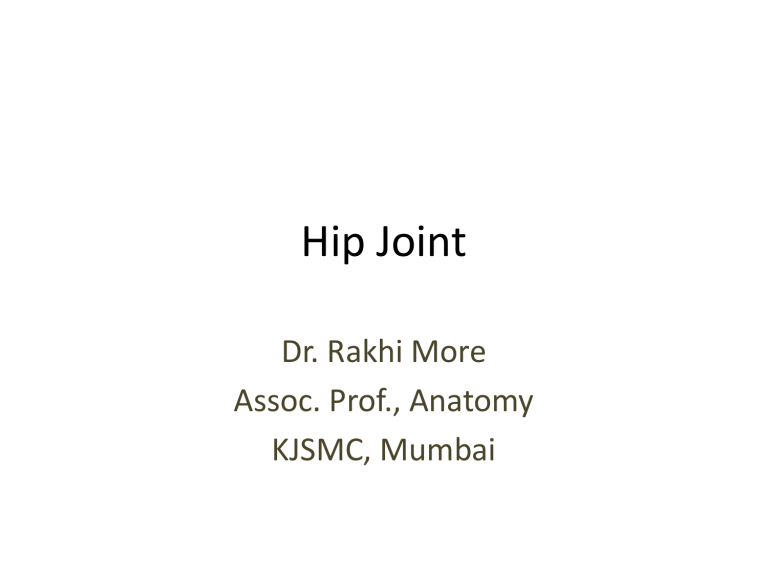
Hip Joint Dr. Rakhi More Assoc. Prof., Anatomy KJSMC, Mumbai Type & Subtype • Synovial • Ball & Socket Articular surfaces • Head of femur • Acetabulum of Hip bone Stability of the joint Depends on • Depth of the acetabulum & narrowing of the mouth by the acetabular labrum • Tension & strength of the ligaments • Strength of surrounding muscles • Length & obliquity of the neck of femur • Atmospheric pressure Ligaments • • • • • • • Fibrous capsule Iliofemoral ligament Pubofemoral ligament Ischiofemoral legament Ligament of head of femur Acetabular labrum Transverse acetabular ligament Ligaments – Fibrous Capsule Attachment on the • Hip bone – acetabular labrum & transverse acetabular ligament & bone above & behind the acetabulum • Femur – intertrochantreric line in front & 1 cm medial to the intertrochanteric crest behind Ligaments – Fibrous Capsule • Anterosuperiorly – Capsule is thick & firmly attached • Posteroinferiorly – Thin & loosely attached Ligaments – Fibrous Capsule • Made up of 2 types of fibers • Outer longitudinal – Best developed anterosuperiorly where they are reflected along the neck to form the retinacula along which the blood vessels supplying the head & the neck of femur travel • Inner circular Ligaments – Iliofemoral ligament • • • • Ligament of Bigelow Present anteriorly Inverted ‘Y’ shaped One of the strongest ligaments in the body • Attached above to the lower half of the anterior inferior iliac spine & below to the intertrochanteric line Ligaments – Pubofemoral ligament • Present medially • Triangular in shape • Attached superiorly to the iliopubic eminence, obturator crest & obturator membrane & inferiorly merges with the anteroinferior part of the capsule& with the lower band of iliofemoral ligament Ligaments – Ischiofemoral ligament • Present posteriorly • Fibers extend from ischium to acetabulum Ligaments - Ligament of the head of femur • Round ligament/ ligamentum teres • Flat & triangular • Apex attached to the fovea capitis & base to the transverse ligament & margins of the acetabular notch Ligaments - Acetabular labrum • Fibrocartilaginous rim attached to the margins of the acetabulum • Narrows the mouth of the acetabulum Ligaments - Transverse ligament of acetabulum • Bridges the acetabular notch • Converts it into foramen which transmits acetabular vessels & nerves Relations Blood supply • 2 4 5 2 3 1 Nerve supply – Femoral Nerve Movement Chief muscle 1 Flexion Psoas major & iliacus Accessory muscle Pectineus, rectus femoris & sartorius, adductors 2 Extension Gluteus maximus & hamstrings - 3 Adduction Adductor – Longus, brevis, magnus Pectineus & gracilis 4 Abduction Glutei – medius & minimus Tensor fascia lata & sartorius 5 Medial rotation Tensor fascia lata & anterior fibers of glutei medius & minimus - 6 Lateral rotation Two obturators , two gemelli & quadratus femoris Piriformis, gluteus maxius & sartorius Applied anatomy • • • • • • Congenital dislocation Trendenlenberg test Perthe’s disease Coxa vara & coxa valga Referred pain to knee Aspiration of hip joint • • • • • Arthritis Fracture Shenton line Hip joint replacement Hip diseases Congenital Dislocation • More common in hip than in any other joint • Upper margin of acetabulum is developmentally deficient • Hence head of femur slips upwards onto the gluteal surface of the ilium • Sciatic nerve injured in posterior dislocations Trendenlenberg’s test • A positive Trendelenburg sign is identified when the patient is unable to maintain the pelvis horizontal to the floor while standing first on one foot and then on the other foot Perthe’s Disease • Pseudocoxalgia • Destruction & flattening of head of femur • X ray shows increased joint space Coxa Vara and Coxa Valga • Coxa vara is a deformity of the hip, whereby the angle between the head and the shaft of the femur is reduced to less than 120 degrees • Coxa valga describes a deformity of the hip where there is an increased angle between the femoral neck and femoral shaft. Referred pain to Knee • Pain referred to the knee because of the common nerve supply Aspiration of Hip Joint • Done by passing the needle from a point 5 cm below the ASIS, upwards, backwards & medially • Can also be done from the side by passing the needle from the posterior edge of the greater trochanter, upwards & medially, parallel with the neck of the femur Arthritis • The position of the joint is partially flexed, abducted & laterally rotated Fracture • • • • Subcapital Cervical Basal Damage to retinacular arteries causes avascular necrosis of the head • Common in old age Shenton Line • In an X ray picture, a continuous curve formed by upper border of obturator foramen& lower border of neck of femur is seen • This line is distorted in fracture neck femur Hip joint replacement • In case of avascular necrosis of the head of femur, hip joint replacement can be done Hip Diseases • Hip diseases show an interesting age pattern: A. Below 5 years of age : Congenital Dislocation and Tuberculosis B. 5 to 10 years : Perthe’s disease C. 10 to 20 years : Coxa Vara D. Above 40 years : Osteoarthritis THANK YOU

